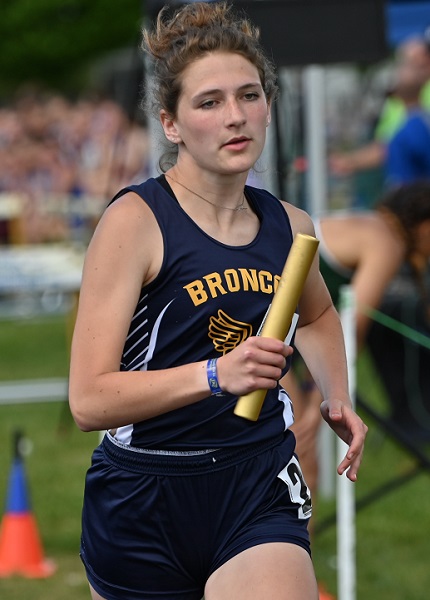
MHSAA Vault: MIS Rose to Challenges to Host 2020 LP Finals
By
Rob Kaminski
MHSAA benchmarks editor
November 12, 2021
The “MHSAA Vault” features stories from past publications and other documents in the MHSAA Library. This issue takes a look at the MHSAA Cross Country Finals at Michigan International Speedway, which celebrated 25 years in 2020 – although it was an event that nearly didn’t happen last fall …
In 1996, the MHSAA and Michigan International Speedway began a partnership the changed the course of the Lower Peninsula Cross Country Finals – quite literally.
The land in and around the track at Brooklyn would host the Finals for all classes of runners in one place on one day, an annual festival of nearly 2,000 runners competing for the MHSAA’s top honors.
Even skeptics – and there were several among running purists who thought the course was too flat, for example – can’t deny the results.
Finals attendance nearly doubled in that first year, and crowds in excess of 10,000 have enjoyed a day of racing several times, including a record 12,153 in 2011.
Enthusiastic crowds were the norm in recent years, with 11,232 in 2017, and nearly 11,000 in 2018 (10,989) and 2019 (10,873).
In fact, attendance failed to reach at least 8,000 only twice since the move to MIS.
Of course, last year was an exception, when attendance was limited to 1,000 spectators per session due to the COVID-19 Pandemic. Fans also were restricted to the grandstands rather than following the action throughout locations on the course.
To reduce the number of runners in each race, the event was spread over two days, with each Division being run in two separate “sections” with times then combined at the end to determine team and individual champions.
While not ideal, the end result was another year of fantastic efforts at MIS – both from student-athletes and those behind the scenes.
“Even at the last hour, less than a week ahead of the Finals, we were closer to not having the Finals than we were to having them,” said MHSAA Assistant Director Cody Inglis, who coordinates the cross country postseason. “Rumors and challenges of mandated shutdowns, testing and other requirements were being discussed and caused a lot of unknowns. Even at the Regional level, we had schools, Regional courses and hosts shutting down their facilities; we had to relocate four Regionals 48 hours prior to race times. That scenario just could not happen at the Finals level where far more runners and much more travel would be involved.”
Among the many last-minute hurdles was the edict from NASCAR – which owns MIS – that all persons on site be temperature checked upon entry. That meant securing thermometers that were easy to operate in short order, along with personnel necessary to conduct the readings.
The attendance limitations certainly helped to implement the temperature screening, but brought their own issues.
“Limiting spectators was not a popular decision, but it really was the only way to have a race,” Inglis said. “We were taking direction and working with policies and protocols from the MDHHS, the Governor’s office, Lenawee County Health Department, MIS and NASCAR.”
Part of the solution was to utilize the grandstands as a “barrier” between participants and spectators. The reduced number of fans were dispersed over thousands of seats while still allowing them the chance to watch their student-athletes compete.
“It wasn’t the same, it wasn’t easy or perfect, but it was what we had to do to have a race,” Inglis said. “Separating the Finals into two days and different sections also allowed us to spread out the event and limit the number of people on site at any one time. This was a key part of the plan and worked well even though it separated races within a Division.”
The MHSAA, MIS and the cross country community never lost focus of the main goal: a culmination of the season for the student-athletes, who deserved something last year more than ever. And, more than ever, MIS once again displayed its advantage as a venue that could adapt to the fluid nature of the times to pull off the event.
“There were some thoughts of using four different sites, but as we learned during the Regionals, the climate of things was so tenuous from one area of the state to another that we couldn’t be 100-percent certain that there wouldn’t again be last-minute cancelations,” Inglis said. “MIS was wonderful to work and collaborate with, and was the best option to get it done. It was never mentioned once publicly about the possibility of not having the Finals – only how we could best do it under uncharted conditions.”
The moving parts and ever-changing scenarios created more complexity than ever in finalizing a season, but every decision was made with the complete desire to conduct the Finals as close to normal as possible.
“I firmly believe that a finish to the season, no matter the differences in race formatting and fan experience, was something everyone would have taken when the season began in August,” Inglis said.
Indeed, the finish line in Year 25 at MIS might have been the most gratifying of them all.

Neighbors North Central, Bark River-Harris Teaming Up in Cross Country
By
John Vrancic
Special for MHSAA.com
September 21, 2022
POWERS — Student-athletes from Bark River-Harris have waited a long time for their opportunity to participate in cross country.
 After a few unsuccessful attempts to start a program at BR-H, a handful of its students are finally getting their chance to run this fall by combining forces with neighboring North Central through a co-op venture.
After a few unsuccessful attempts to start a program at BR-H, a handful of its students are finally getting their chance to run this fall by combining forces with neighboring North Central through a co-op venture.
Wes Knauf, a sophomore at BR-H, led the Jets by placing sixth in the Munising Invitational on Aug. 23, covering the hilly 3.1-mile course in 20 minutes, 37 seconds.
“During the fall, our biggest sport is football,” he said. “I think it’s a great opportunity for us to have cross country. I wanted to run cross country because I want to get better. This gives me more conditioning for track. I enjoy it. I started a little nervous, but now I feel more comfortable with it.”
And the BR-H students were welcomed with open arms.
“Overall, I’m happy with the way the teams have progressed, and we’re happy to have a full girls team,” second-year North Central coach Mike Jenkins said. “We have only three boys, but we couldn’t ask for a better three.”
Three of the team’s five girls are from BR-H, including junior Julia Olson and sophomore Hope Varoni, who also play volleyball for the Broncos and were big contributors as the girls track & field team won the Upper Peninsula Division 2 championship in June.
“(Cross country is) pretty busy and demanding on my body,” said Olson. “At first I was pretty nervous, but now I’m enjoying it.
“I enjoy running through the woods. It was really hot (Sept. 7) at Manistique. It reminded me a little bit of last year’s track Finals (at Kingsford) because of the heat. This definitely helps for other sports because you’re better conditioned.”
 Varoni led the Jets at Munising by placing 15th.
Varoni led the Jets at Munising by placing 15th.
“I was pretty nervous, but I’m also pretty competitive,” she said. “I’m a middle distance runner in track, so this helps my conditioning for sure.
“It feels great to have this opportunity. We’re like a little family. When we go on road trips, it’s a great time. That gives us a chance to bond as a team.”
The North Central girls team finished second at Saturday’s Superior Central Invitational, with Varoni finishing third in the individual standings. Knauf was third in the boys race.
“It’s great to have Wes,” said North Central sophomore Alex Pipkorn. “We don’t have a full team, but it’s great to compete anyway. Anything helps. The more runners we have, the better it is.”
North Central sophomore Ella Riley also plays volleyball for the Jets.
“It feels real good to have a full (cross country) team,” she said. “I enjoy having the girls from Bark River-Harris with us. … I think our team has lot of potential. I think we can do a lot with that.”
BR-H junior Faith Javurek needed a little bit of convincing prior to joining the team.
“I wasn’t sure I wanted to do it because I didn’t know what to expect,” she said. “I’ve been running at home because I couldn’t make it to many of the practices, but it’s exciting.”
Sophomore Madelyn Corrigan, who joined the team last week, was set to make her debut at Superior Central.
“It was kind of hard on the first day,” she said last week. “I’m kind of nervous going into the first meet, but I’m doing it to get in shape for basketball.”
Senior Jesse Sampson said he’s more of a middle-of-the-pack runner, but also sees the wide-view benefits of running with the team. He finished 32nd at last season’s UPD3 Cross Country Finals, when the Jets had four racers – one short of getting to compete as a full team.
“I’m mostly competing with myself,” he added. “Three miles isn’t crazy long.
“The most rewarding part of cross country is meeting different kids and making friendships. It’s a benefit having Wes on the team. Competition-wise we don’t have enough for a team score, but it’s light-hearted and fun.”
 John Vrancic has covered high school sports in the Upper Peninsula since joining the Escanaba Daily Press staff in 1985. He is known most prominently across the peninsula for his extensive coverage of cross country and track & field that frequently appears in newspapers from the Wisconsin border to Lake Huron. He received the James Trethewey Award for Distinguished Service in 2015 from the Upper Peninsula Sportswriters and Sportscasters Association.
John Vrancic has covered high school sports in the Upper Peninsula since joining the Escanaba Daily Press staff in 1985. He is known most prominently across the peninsula for his extensive coverage of cross country and track & field that frequently appears in newspapers from the Wisconsin border to Lake Huron. He received the James Trethewey Award for Distinguished Service in 2015 from the Upper Peninsula Sportswriters and Sportscasters Association.
PHOTOS (Top) Powers North Central’s Jesse Sampson (283) runs during last season’s UPD3 Cross Country Finals. (Middle) Julia Olson runs a leg of the 1,600 relay for Bark River-Harris this past spring at the UPD2 Track & Field Finals. (Photos by Cara Kamps/Run Michigan.)

